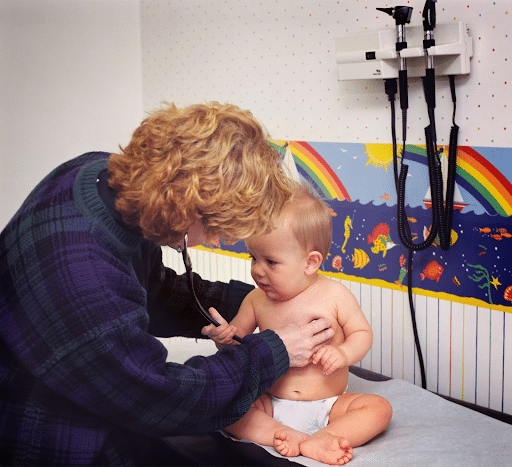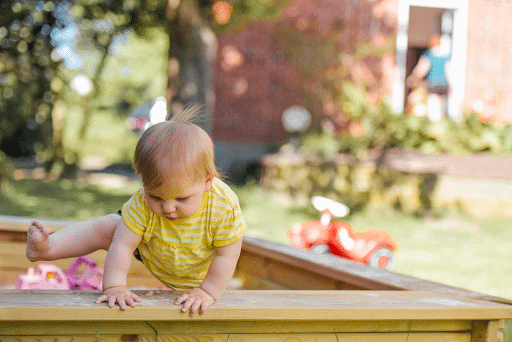As a physical and occupational therapist student, you probably heard the term “tethered cord syndrome” in school. The condition was likely quickly brushed over with a brief description on one PowerPoint slide.
Fast forward years later, as a practicing pediatric therapist, you are presented with a complex case of mysterious signs and symptoms. You are treating a potty-trained child for urinary incontinence, but his bladder issues get progressively worse. Then he begins to develop headaches and you notice he’s starting to limp.
Multiple doctors are unable to determine a diagnosis initially, but eventually, the child is given multiple diagnoses. The urologist gives the diagnosis of neurogenic bladder, the neurologist confirms migraines, and the orthopedist discovers hip dysplasia.
The world is a nail when you have a hammer, right? But you know the child’s issues are somehow all connected.
Medical runaround is probably more common than you think. This news article describes a family’s painful journey through the medical system and how a mother used ChatGPT to discover her son’s diagnosis.

One day, a light bulb turns on, and you remember that one slide from school. “Tethered Spinal Cord Syndrome”. All the signs and symptoms seem to fit. So you talk to the child’s parents and ask if any doctor ever mentioned this tethered cord syndrome.
You know that as a therapist, diagnosing disease is not within your scope of practice. But asking the right questions to the right people IS within your scope.
Your therapist superpower is using your knowledge to recognize conditions and then communicating with parents and physicians.
This blog will help you to understand what tethered cord syndrome is, how to recognize it, and how you can help children with this condition. Let’s go hone your superpower!
What Is Tethered Spinal Cord Syndrome?
Tethered cord syndrome (TCS) is a pathological fixation of the spinal cord, resulting in myelopathic signs and symptoms. These neurological impairments can affect multiple body systems, causing:
- motor and sensory deficits
- structural and postural musculoskeletal changes
- gastrointestinal dysfunction
- genitourinary dysfunction
In TCS, the spinal cord is fixated by inelastic structures, usually in the distal spinal regions. Fixation commonly occurs at the conus medullaris, the cauda equina, or filum terminale, but it’s possible to occur at higher segments.
This fixation causes a longitudinal traction of the spinal cord, pulling the cord caudally. The traction can often be visualized on MRI by looking at the end level of the conus medullaris, which typically terminates at L1-L2 intervertebral disc level. If the conus terminates at a lower level, there is greater concern for TCS.
Neurological changes result when mechanical traction and/or compression forces cause vascular ischemia in the neural tissue. Neurological effects can be localized to the site of tethering and also transmit forces to neural tissue far away from the site. This is why you may see such a variety of clinical presentations in TCS.
Don’t be afraid to ask questions and raise concerns in these cases because permanent spinal cord damage can result from ischemia. Early diagnosis and treatment are imperative!
Now that you understand what TCS is, let’s discuss the etiology.
Causes Of Pediatric Tethered Cord Syndrome
Tethered cord syndrome is more prevalent in the pediatric population compared to the adult population, making you more likely to come across these cases as a pediatric therapist.
TCS can be an isolated finding but is more frequently a secondary component of other causes. Inelastic structures such as these can cause tethered cord:
- Fibrous or lipomatous filum terminale
- Myelomeningocele
- Meningocele manque
- Lipomyelomeningocele or lipoma
- Bony spicule
- Scar tissue
- Dermoid sinus
- Split cord malformation
These inelastic structures can be congenital, developmental, or acquired.
In pediatrics, spinal dysraphism (spina bifida) is commonly the cause. This congenital condition is a neural tube defect, in which the spinal vertebra or neural tube don’t close all the way. Protrusion of tissue (meninge, spinal cord, nerve roots, or fat) through the defect can anchor neural tissue.
You’ve probably seen many pediatric patients with spina bifida. This population is at higher risk for TCS, so keep your eyes and ears alert for red flags.

Tethering can be caught early at a young age, or it may not present until the child grows more or has a growth spurt. As the child progresses through development, increased mechanical tension can stretch and distort the spinal cord, causing ischemia.
In this case, you may see a child who’s been growing and developing appropriately, but then begins to regress and lose motor skills. Or you may also see a potty trained child present with urinary leakage when they have been dry for years.
An acquired form of TCS can result from spinal cord injury. The body lays down scar tissue after injury to the spinal cord, which can cause tethering.
Don’t be overwhelmed by the list of all the TCS causes. You don’t have to memorize them!
Just understand that birth defects, growth spurts, and spinal injuries can put kids at increased risk. Then be able to recognize the signs and symptoms.
Signs And Symptoms Of Pediatric Tethered Cord Syndrome
As you read above, neurological impairments from TCS can affect multiple body systems, depending on the level of tethering. Most commonly it occurs in the lumbar, sacral, or coccygeal regions.
Children may have a sacral dimple or pilonidal dimple, which is a depression in the skin above the buttocks. This is not indicative of TCS, but a mark to check for if you suspect TCS.
Sacral dimples are similar to the tuft of hair or discoloration that you’ve probably seen in children with spina bifida occulta. The cyst seen in spina bifida aperta/cystica is a more pronounced deformity that you can easily recognize. Again, not indicative of TCS, but just signs to be aware of.
Pain is a symptom in children, often in the back, legs, or anorectal area. This is often exacerbated with sitting or leaning forward for extended periods of time. Pain is more common in adults than kids, but none-the-less an important symptom to ask your kids about.

Clinical signs to look for:
- Progressive weakness in one or both legs. Typically weakness is seen in one leg.
- Numbness or sensory changes in the legs or saddle region.
- Lower and upper motor neuron lesions. While there may be weakness, there may also be spasticity.
- Orthopedic problems, such as scoliosis and foot deformities (high arches, clubfoot, hammertoes). Chronic muscular weakness, atrophy, and spasticity can eventually contribute to the orthopedic changes.
- Toe walking
- Developmental skill regressions
- Pelvic floor, bladder, and bowel function, affected by lower and upper motor neuron lesions. This can be accompanied by frequent UTIs. You’ll take a closer look at this in the next section.
Pediatric Neurogenic Bladder Resulting From Tethered Cord Syndrome
Neurogenic bladder when nervous system damage causes a loss of normal bladder function. Characteristics include insufficient bladder emptying, involuntary escape of urine, or neurogenic overactivity of bladder.
Tone of the bladder is affected by both the detrusor muscle and the urethral sphincter. With healthy neurological function, the detrusor and the pelvic floor (PF) act reciprocally to allow for proper urinary storage and voiding.
There are 4 types of neurogenic bladder that can occur, depending on the level of neural involvement. Urodynamic testing must to be done to classify the dysfunction:
- hyperreflexia of detrusor & PF
- hyperreflexia of detrusor & hyporeflexia of PF
- areflexia of detrusor & hyperreflexia of PF
- areflexia of detrusor & PF
Your treatment is based on findings of the urodynamic testing. Depending on the type, bladder training and clean intermittent catheterization is done.
In children with spina bifida, their quality of life is related to their problems with urinary leakage. This is why urinary scheduling is so important to improve their wellbeing.
The most crucial reason for treatment of neurogenic bladder is to prevent reflux of urine up into the kidneys and to preserve renal function.
Surgical Treatment Of Pediatric Tethered Cord Syndrome
If the child’s physician suspects a tethered cord, MRI is used to visualize the level of the conus or any abnormalities. However, MRI isn’t always accurate in identifying TCS because the imaging is done in a stationary (usually supine) position. TCS is a functional diagnosis, so a dynamic MRI would be ideal to visualize the tethering.
Once a child is diagnosed with TCS, detethering surgery is standard. The procedure requires excision of the underlying cause and release of the spinal cord.
Tethered cord release is generally regarded as safe, with low readmission, reoperation, and complication rates. But as with any surgical procedure, there is risk. Complications may include:
- impaired wound healing or wound dehiscence
- surgical site or systemic infections
- CSF leak
- urinary tract infections
- nerve root or spinal cord injuries
Variability in complications is likely due to the wide range and complexity of disorders that are associated with TCS.
As A Pediatric Pelvic Floor Therapist, What Is Your Role In Treatment Of Tethered Cord?
You may be treating the child before surgery. Because TCS puts the child at risk for permanent neurological, urological, and renal damage, management of the neurogenic bladder is extremely important.
The child’s physician may provide medication, depending on the type of neurogenic bladder. Additionally, you will be teaching families how to appropriately use clean intermittent catheterization.

As a therapist, your knowledge gives you the foundation to ask critical questions, evaluate and assess information, and educate families. Your communication skills equip you to be trusted by patients and their families and to be a direct line to physicians.
Through expert thinking and skilled communication, you hold the power to make a difference in a child’s life when no one else is listening.
You can learn about tethered cord syndrome and other pediatric bowel and bladder conditions in my online course: Peds Level 1 — Treatment of Bowel and Bladder Disorders: Evaluation and Treatment of Dysfunctional Voiding, Bedwetting, and Constipation.
